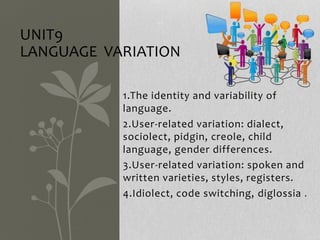
Language Variation and User-Related Factors
- 1. 1.The identity and variability of language. 2.User-related variation: dialect, sociolect, pidgin, creole, child language, gender differences. 3.User-related variation: spoken and written varieties, styles, registers. 4.Idiolect, code switching, diglossia . UNIT9 LANGUAGE VARIATION
- 2. *9.1.The identity and variability of language. * Language variation =synchronic variability. * Is the existence of language varieties side by side. * The coexisting varieties change along the dimension of time = language change = diachronic variability.
- 3. * The problem of language identity: -are two linguistics codes are two languages one says = criterion is mutual understandability but it break down between code of the same language. -e.g.: northern Chinese and southern Chinese may not understand each other. -e.g.: Swedes and Danes understand each other so the mutual understandability not safe criterion. * socio-psychological concept = one language is the sum of the some language. * English = It covers the term of all linguistic codes that regarded as English. * You can regard this chapter as a preliminary introduction to sociolinguistics, as well. * Language variation con be discussed in terms of user-related and use-related variation.
- 4. 9.2.User-related variation : involve the user is geographical and social position * Regional dialect (dialect)= the variety of language in geographical area. * Differ in: 1.vocabulary. 2.pronounciation. 3.morphology. 4.syntax. -e.g.: isogloss = the line marking on a map. * State of Penn Sylvania (USA) the word drought is drooth. * A dialect is a more or less congruent bundle of isoglosses.
- 5. * When regional varieties gains social political priority over the others and become (stander variety). Used for: 1.education. 2.scholarship. 3.State administration all over the country. * It used for educated, who are at the top of socio-cultural scale, no matter where they live. * Social dialect or sociolect: - A sociolect = a variety of language used by people in the same socio-cultural position.
- 6. * Standard variety has higher social prestige _ not Linguistically better than the other varieties. * Standard English was the particular variety in South-East of England rather than a northern and its due to : 1.historical. 2.political. 3.cultural. 4.economic reasons. * Standard English has two major national sub varieties. * Standard British and Standard American not superior to the other. * The greatest difference between them is probably in pronunciation.
- 7. * Received Pronunciation (RP) is the ideal type of pronunciation of Standard British English. * (RP) Received Pronunciation so called because by the 19th, acceptable in polite society in England at curt. * General American (GA) the pronunciation of Standard American English. * Standard British English, with it (RP) is the language of educated people. * Those near the bottom of the socio- cultural scale nearly always use non- standard varieties. * It coincide with regional dialects, examples: -He want it. -I wants it.
- 8. *Double or multiple negation : -non-standard socio-cultural feature used by uneducated English speakers in very different geographical areas.
- 9. *A third type of user-related language variation is Pidgin: -Pidgin: 1-The simplified version of a European language. 2-Containing features of one or more local language. 3-In Melanesian Pidgin English called (Tok Pisin). 4-Pidgin is not a native language, it can become the native language of a community of people who brought together on a plantation from different linguistic backgrounds. *creole: when a pidgin becomes the native language of a community. *Child Language: one could add to the list of user-related varieties the linguistic features that are attributable to the age and sex of the language user.
- 10. *9.3.Use-related variation: spoken and written varieties, styles , registers: 1.The first: -medium: of language use, ie:- by speech and writing. -The language we speak is different from the language we write. -when we write we are more careful. -the language we use in face to face talks tends to the language of telephone conversations. -the language of text-messages is different from the language of letters.
- 11. 2-The second: -Style: the conditioned by the language users relative and social status. -neutral: or unmarked style. -we can distinguish sentences which are markedly formal or in formal *example: a.Formal: I wonder if you'd mind switching off the light. b.Neutral: Would you please switch off the light? c.Informal: Switch off the light, will you? *Familiar: a very informal style. *Slang: a very informal language. *we must use sentences that are not only grammatical and meaningful but also stylistically appropriate. neutral
- 12. 3-The third: -Register: The subject matter in connection with which the language is being used. -we can talk about the registers of: (sports, religion, medicine, computer engineering, cookery, weather forecasts, etc..) -Jargon: when the register of a field is full of technical terms which those who have received no training in that field cannot understand. -Argot or cant: Criminals Jargon.
- 13. *9.4.Idiolect, code switching, diglossia: *Idiolect: The amount of a language that an individual possesses. *Code switching: The ability to change from one variant to another. *Tow distinct varieties of a language co-occur in a speech community one with a high social prestige and the other with low social prestige. *Diglossia : The sociolinguistic term for this mixed styles. *diglossic : an individual having diglossia. *bilingualism and bilingual: Knowledge of two language and person knowing two language.
- 14. Department of English Language and Translation Supervised by: Dr. Khaleel B. Al Bataineh Done by: Omaila Omer Assiad
